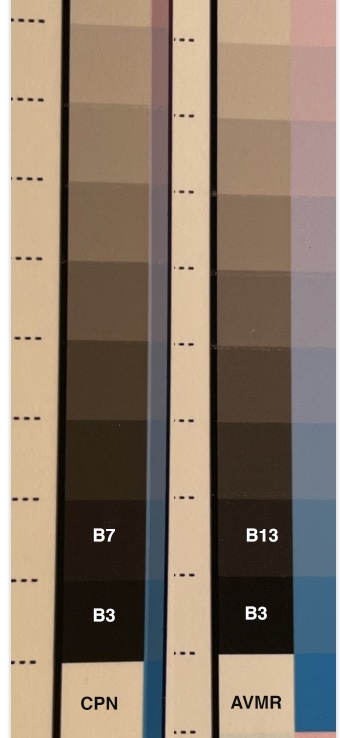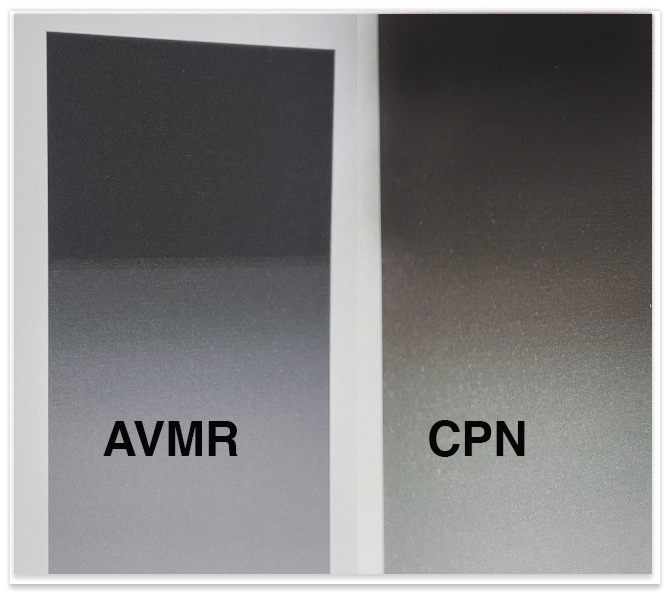Hi Walker (You asked me to post this here, along with several screen shots. Here we go:)
Chart 1600 Patches.tif.zip (44.7 KB)





I’ve just spent three days printing Cone Color Pro profile images and creating .icc profiles. (I’ve probably made 100-150 such profiles over the past 5-6 years, using the i1Profiler software and their spectrophotometer.) I’ve made 98% of these on Resin Coated (RC) paper, as I prefer it to matte for most color work. Recently I have had a need to profile some top-of-the-line matte papers for color work, and I’m seeing something that is odd: gray-scale ramp with a significant and obvious jump in tone near the dark end.
I’m running Big Sur on an iMac Pro, running 11.5.1 with 64 GB RAM. My tools are i1Profiler 3.3.0, with spectrophotometer v2; PrintTool 2.3.2; Photoshop CC 22.4.3 and a P6000 printer with only a few hundred pages printed.
I have NO problem with any of my profiles, until I tried the matte papers. The colors look fine, but a gray-scale ramp fails on the dark end.
I have a large range of papers, from buck-a-sheet Red River (used for testing) to $4 Hahnemuhle Photo Rag; Infinity Arches Velin Museum Rag; Epson Cold Press Natural; Velvet Fine Art; Exhibition Fibre; and a few platines, baraytas and on and on.
(I generally -only- use matte paper for Piezography, and the RCs for color.)
My go-to test image is Bill Atkinson’s with the clock in the upper left; strawberries etc, and the luminesce tone band across the bottom. See attached. (FWIW, Bill and I went to college together…)
A few days ago, I had a need to change to matte printing, and I had not yet created my custom profiles for the K7 inks with matte papers. I ran i1Profiler, and saved out a 1600 square target. Then I used PrintTool to print it to
Epson Cold Press Natural (CPN)
Hahnemuhle Photo Rag (HPR)
Arches Velin Museum Rag (AVMR)
Velvet Fine Art (VFA)
and Red River Aurora Art Natural (RRAAN).
… and let them dry for 24 hours. Next, I scanned them with the Spectrophotometer 2 using single pass M0 (and later using double-pass M0 1,2,3).
I quickly eyeballed the 3-D shapes in Color Think Pro.
That’s the setup.
The issue shows up in the gray-scale tone-band at the bottom of the Atkinson test image. On the RC papers, it looks perfect… smoothly changes from black to white.
However, on all BUT ONE of the matte papers, the black end clogs up. On a 100% print at either 1440 or 2880, unidirectional or bi (about 7.5" x 9.5") the left-most 1" to 1.2" of black appears to be the same tone, -and- there is a clearly visible demarcation between that and the rest of the tone to the right of it, which is appropriately graduated and smooth. (See attached)
The demarcation is so clearly visible that I call it a “jump”. It varies from paper to paper with AVMR the worst offender (meaning most visible).
What’s interesting is this: -one- paper does NOT show it: Epson CPN. (image attached)
Summary: I printed all the targets at the same time; scanned all the targets the following day at the same time, and all the papers show the jump as it moves into black… except CPN.
(NO Resin Coated papers show this -at all-, but I’m talking about the matte papers here.)
I rescanned using Bi-di (M0, M1, M2) instead of single pass M0. It made no difference.
Finally trying to figure out where this was coming from, I again printed the Atkinson test image on AVMR (which shows the jump using the AMVR.icc profile I created) but this time I used the CPN .icc profile instead of the AVMR profile.
And there was NO jump on that print.
So that takes it back to being an issue with the profile… and in turn leads me back to the paper itself, on which the target was printed.
Finally, I took out my thoroughly dry targets, and looked closely at them; specifically the gray-scale ramp squares (10 of the 1600 samples). And there I saw what I think to be the explanation: that the next-to-last square before pure black was -lighter- in the -all- the matte paper targets than it was in the CPN target print. (See attached.)
That is, the gray level brightness between black and the next lighter square is -greater- (10) on all the papers than it is on the CPN paper (4). I’m pretty sure that this is what leads to the “jump” in the test print.
That’s it. Not sure what I want from you, if only a confirmation of this. It’s Cone inks vs several very expensive papers. If it was 100% repeatable, that would be one thing, but it’s not. I can print the same 1600-patch tif on all my RC papers AND on the Epson Cold Press Natural matte paper, and the resulting icc color profiles (and prints) are just fine.
BUT on AVMR, HPR and VFA and RRAAN, the gray-scale ramp in Bill’s test image is corrupt.
Have you seen this before? Any comments? Suggestions?
Thanks for your time. Again: no rush… Just thought you’d be interested.
Tracy Valleau
 )
)